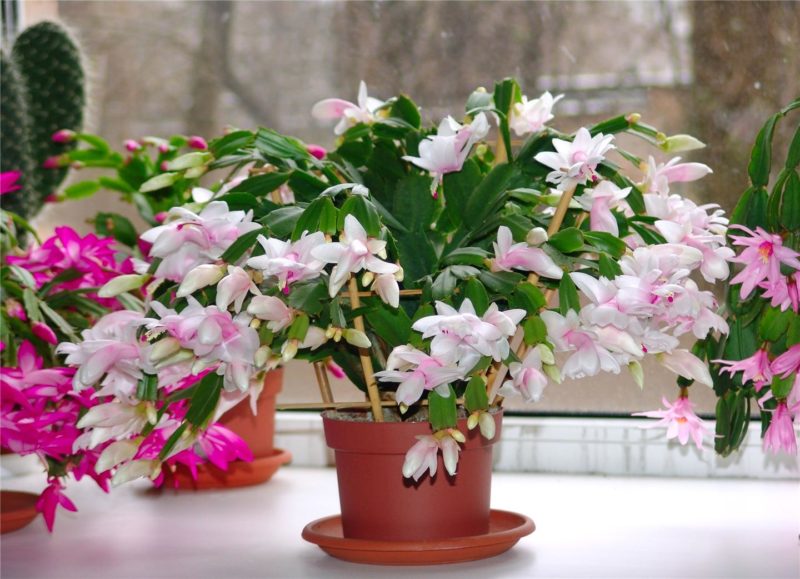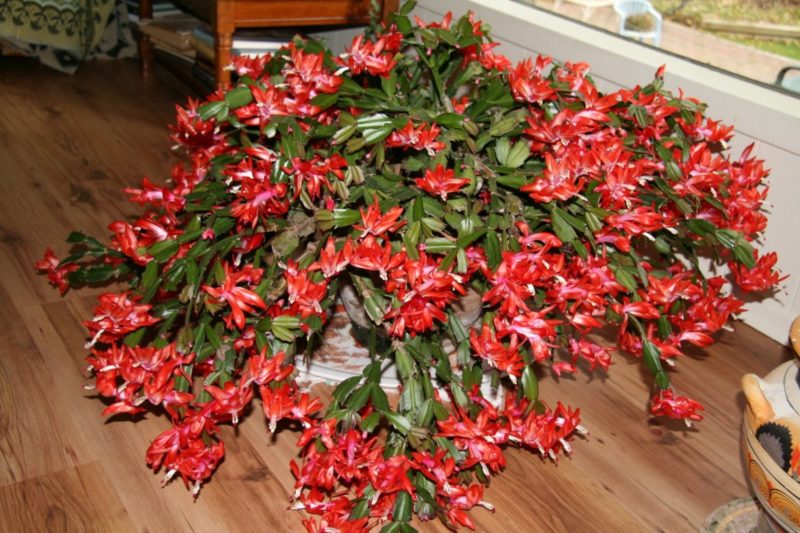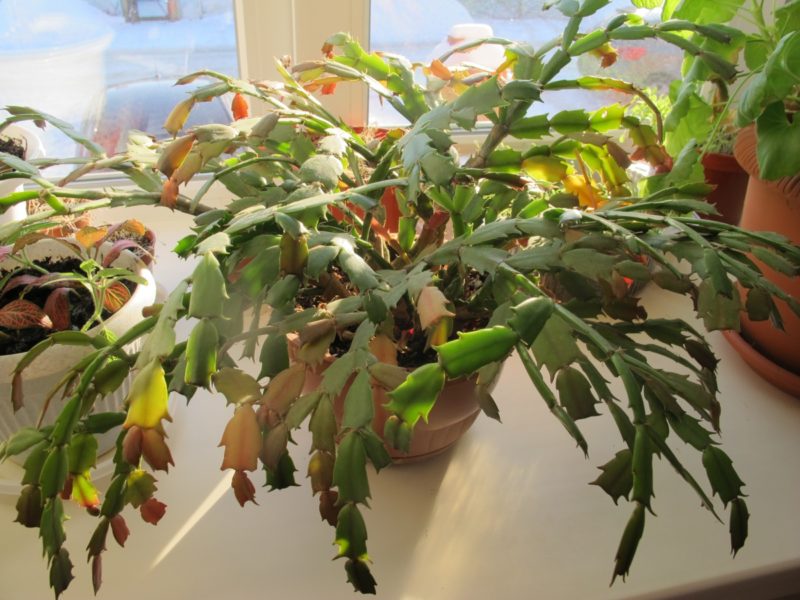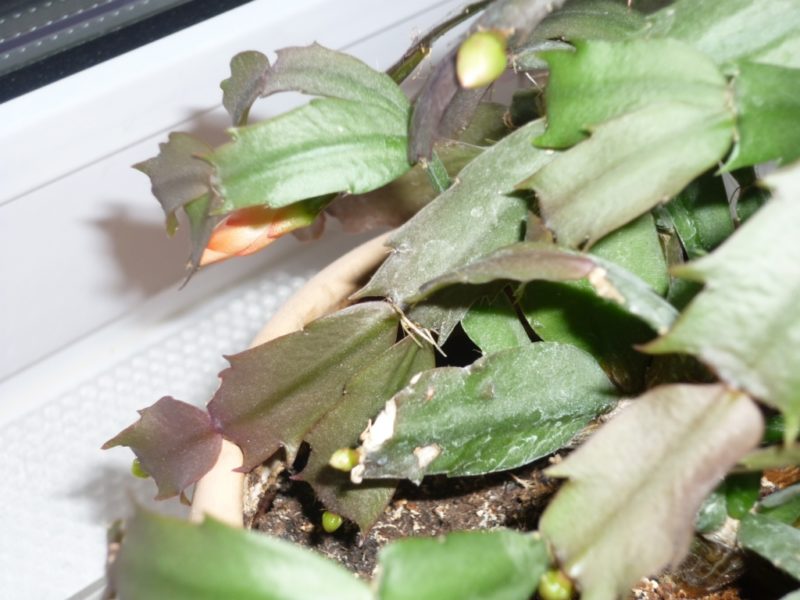At the moment when there are crackling winter frosts outside the window, an unusual tropical cactus is blooming on the windowsills. It has no needles, has dark green shoots and pleases the owner with the appearance of buds only once a year. Caring for a Decembrist flower at home is different from caring for other cacti, but there is no difficulty in it.
Material Content:
Decembrist flower - cultivation features
The Decembrist is a forest cactus that grows in the wild on the trunks of tropical trees. Their root system is not very resistant to adverse factors, this can cause the death of the plant. The flowering of the Decembrist begins in November and ends in February.

With proper care, the plant can live up to 20 years
During flowering, you can not rotate or move the pot, because of this, buds may fall. The Decembrist does not like dry air, so it is permissible to spray it from the spray gun. In order to prolong flowering, you can cover the plant stem with snow or ice from the refrigerator.
How to care for the plant at home
The Decembrist loves water, which is how it differs from other cacti. You need to water it with warm liquid, and you can also place the flower on a pallet with wet pebbles. It is better to grow it on the eastern windows. In the summer, the flower can be taken out into the fresh air, and in winter, the indoor temperature can be maintained at least 10-11 degrees Celsius.Avoid exposure to direct sunlight and do not turn it with only one side to the light, otherwise the plant will be “one-sided”.
The Decembrist is susceptible to fungal and bacterial diseases, so it must be inspected periodically. Possible damage to the flower by a spider mite, scabbard and mealybug. At the first signs of the disease, it is necessary to begin treatment with drugs.
Lighting, temperature
Decembrist can not be kept in the scorching sun, it will be much more comfortable for him in diffused lighting. It is best placed on the eastern or northeastern windows. If zigocactus can be placed only on the south side, then the plant will need to be shaded to avoid sunburn.

For flowering, the Decembrist needs a short day, this period falls on the winter. The temperature in the room at this time drops to 10-15 degrees. It often happens that only the part of the flower that faces the cold window blooms. But it is also impossible to lower the temperature too, the plant does not tolerate frost and can die. In the summer, the Decembrist feels great at 18-24 degrees Celsius.
Soil requirements
First of all, you need to carefully consider the choice of soil for the pot. Decembrist loves light nutrient soil with good drainage. The soil should easily pass moisture and air. Often for these purposes a mixture of peat, sheet land and sand is used. Also, humus and sod can be added to the soil. The best soil for Decembrist is slightly acidic. You can use the finished soil mixture for succulents.
Before planting a flower, the ground must be sanitized. For these purposes, crushed coal can be used. For greater airiness of the soil, small pieces of wood bark and perlite are added to it.
Read also:caring for a fat woman
Watering, top dressing
The plant is watered all year round. Although a cactus can store a certain amount of water in the leaves, it will not be enough for a long time. Decembrists in nature grow in tropical rainforests and they need fluid. Drought will lead to the death of the roots and death of the plant.

Watering should be constant, but moderate. With prolonged waterlogging, the roots of the plant can rot. Water the flower after the topsoil has dried. You can install the pot on a tray with wet pebbles.
From the beginning of September, the Decembrists begin to feed with potash fertilizers and stop after flowering begins. After the buds fall, the plant rests from nutritional supplements. From March to April, tropical cactus is fed with complex fertilizer for potted flowers.
How to trim the Decembrist?
June is the best time to circumcise the Decembrist. In order to form a beautiful crown, shoots that grow incorrectly are removed. After the procedure, the plants bloom more intensively and look better. It is better not to cut the shoots, but to turn them off, so less damage is done to the flower.
Transfer
The young Decembrist needs a transplant once a year, in the spring. The pot is not chosen too large, since it is easy to water the plant in it. Adult Decembrists transplanted every 3-5 years.
It is best to choose a low but wide pot. The plant is forbidden to transplant during flowering, this will negatively affect its health. A third of the container is filled with drainage, the rest is occupied by the soil layer, which is pre-disinfected with crushed coal.
When transplanting, loosen the ground along the edges of the pot and remove the plant along with the ground. Lightly clean the root system of soil residues and deepen the Decembrist into new soil. After transplanting, water the flower plentifully.
Care after flowering

After flowering, the Decembrist is moved to a cool place and limited a little in watering. The room should be protected from direct sunlight, it is better if there will be partial shade in it. In late March, the flower is transferred back and increase the flow of moisture.Mineral fertilizers also begin to be applied.
Decembrist flower propagation
Decembrists flowers propagated by short cuttings, 2-3 links in each. Pieces of stems are carefully broken off from the plant and left to dry for 2-7 days. For faster rooting, the procedure is carried out in the spring-summer period, when the night is shorter than the day. The best temperature for breeding Decembrist is 25 degrees Celsius.
Before planting, treat the lower tip with Kornevin and deepen the stalk into the substrate. The best soil will be a mixture of equal parts of peat and perlite. Water the plant abundantly. Spray the flower from the spray bottle periodically, this will contribute to faster rooting.
You do not need to create a greenhouse effect by covering the shoot with a glass jar or a bottle. With free access to air and favorable temperature conditions, the plants are perfectly rooted. Make sure that the soil does not dry out. Keep the flower in the shade and avoid direct sunlight.
Many flower growers combine the propagation of Decembrist with its pruning, because in the process a large number of cuttings are formed. Since the plant is cut in June, this is justified, because in the summer months it is favorable for obtaining new zygocactus.
Pests and possible plant diseases
The Decembrist is quite resistant to damage by pests and other diseases with proper care.

Dangerous for the plant insects:
- mealybug;
- spider mite;
- scale shield.
Read also: mealybug: how to fight on indoor plants
To get rid of pests, it is best to use special preparations sold in the flower shop. For prophylaxis, the plant should be regularly inspected and sprayed.
Decembrist is also susceptible to infections:
- bacterial;
- fungal.
Prevention is a regular inspection of the flower and quick treatment when the first signs of the disease appear.
With a bacterial infection, wet slippery spots appear on the plant. For treatment, you can remove the affected shoots, but not always this method gives a positive effect and the disease spreads. In this case, you can take healthy cuttings for propagation and root them, and destroy the old plant.
With a fungal infection, the Decembrist becomes pale, the shoots begin to fade. This is due to damage to the root neck of the plant. For treatment, drugs are used that can be purchased at a flower shop, for example, Topaz or Maxim.
Why does the Decembrist not bloom, wither, fall off?
If the Decembrist does not bloom, then either there are errors in caring for him, or the plant is sick.
The most common causes of poor zygocactus are:
- defeat by insect pests or infection;
- scanty moisture;
- bad light;
- insufficiently nutritious soil;
- the room is too hot;
- the pot has become small and the plant needs a transplant.
If you have recently purchased a flowering Decembrist and his buds have fallen, then you should not worry, so the plant reacts to a change of room.












